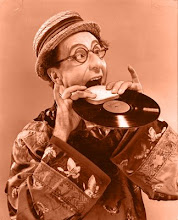The Terror-ific Second Annual Third Banana Halloween Anniversary Spooktacular Clip-O-Thon!
Two years, 212 posts and counting, folks, and we ain't dead yet! Here are a few ghost-tastic ghoul-clips for your vampire-joyment. Boo!
Bela Lugosi performs the "Vampire Bat Illusion" with Shirley Patterson in this 1953 episode of You Asked For It. At the end, Bela references a couple of never-to-be projects: The Phantom Ghoul (in 3-D!) and a TV series, Dr. Acula ("Dracula?" asks host Art Baker. "Dracula??" replies Bela, shocked. "For heaven's sake no! Just.. Dr. Acula!").
Germán Valdés 'Tin-Tan' and his brother Manuel 'Loco' Valdés perform a spirited (ho ho!) number entitled "Un Sueño Es Solo Un Sueño" in Los Fantasmas burlones (1965). Antonio Espino 'Clavillazo' and Adalberto Martínez 'Resortes' watch from the audience. Mexicomics and in-camera effects galore! God, I love this film!
Atlanta TV horror host Bestoink Dooley (George Ellis) also starred in his own regional film, The Legend of Blood Mountain, in 1965. It's a jaw-dropper. Some of the boldest, most in-your-face padding in the history of film, bargain monster, awkward comedy sequences, and Groucho's girlfriend/secretary/live-in tormentor Erin Fleming in her first motion picture! It's much less a comedy than The Wacky World of Doctor Morgus, and not just because most of the comedy falls flat. They went for more scares than laughs and, unfortunately, failed to deliver either.
Here's a little stretch of padding I like to call... Bestoink Dooley Goes to Sleep!
Nighty-night! IF YOU DARE!!
Bela Lugosi performs the "Vampire Bat Illusion" with Shirley Patterson in this 1953 episode of You Asked For It. At the end, Bela references a couple of never-to-be projects: The Phantom Ghoul (in 3-D!) and a TV series, Dr. Acula ("Dracula?" asks host Art Baker. "Dracula??" replies Bela, shocked. "For heaven's sake no! Just.. Dr. Acula!").
Germán Valdés 'Tin-Tan' and his brother Manuel 'Loco' Valdés perform a spirited (ho ho!) number entitled "Un Sueño Es Solo Un Sueño" in Los Fantasmas burlones (1965). Antonio Espino 'Clavillazo' and Adalberto Martínez 'Resortes' watch from the audience. Mexicomics and in-camera effects galore! God, I love this film!
Sid Noel's Morgus the Magnificent was, in my opinion, the cleverest of the 50s-60s TV horror hosts (perhaps I should say is as Dr. Morgus is reportedly still in the game). As much as I like Ghoulardi and Zacherly, Dr. Momus Alexander Morgus tops them all thanks to Noel's wonderfully dry delivery, clever physical comedy, and his insistence on backing his character up with a performance philosophy. Based out of New Orleans, Dr. Morgus was the first horror host to star in his own regional feature, The Wacky World of Doctor Morgus, in 1962. In all, it's not a particularly good movie, but whenever the silly plot is shoved out of the way long enough for one of Dr. Morgus's lab-based set-pieces, it shines. Some of the best early-60s "sick" humor I've seen.
Atlanta TV horror host Bestoink Dooley (George Ellis) also starred in his own regional film, The Legend of Blood Mountain, in 1965. It's a jaw-dropper. Some of the boldest, most in-your-face padding in the history of film, bargain monster, awkward comedy sequences, and Groucho's girlfriend/secretary/live-in tormentor Erin Fleming in her first motion picture! It's much less a comedy than The Wacky World of Doctor Morgus, and not just because most of the comedy falls flat. They went for more scares than laughs and, unfortunately, failed to deliver either.
Here's a little stretch of padding I like to call... Bestoink Dooley Goes to Sleep!
Nighty-night! IF YOU DARE!!
Labels: Bela Lugosi, Bestoink Dooley, cinema, Clavillazo, Loco Valdez, Morgus the Magnificent, Resortes, Tin-Tan, TV























